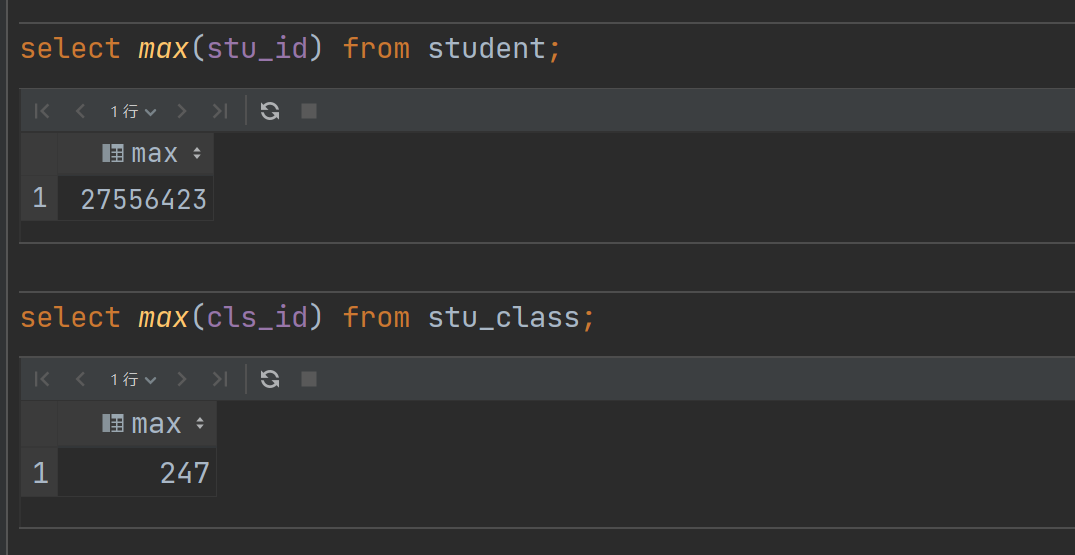postgresql 去重计数改写案例
最近帮忙在搞一个内网报表系统的项目,里面的逻辑比较复杂,很多视图套视图的语句。
最多的一个视图除了它本身以外,一层层嵌套了7个视图在里面,贼恶心。
SQL遇到性能问题只能每一层视图捋清对象关系来排查缓慢的原因,只看执行计划根本行不通,慢的语句根本跑不出结果。
这两天就遇到个很郁闷的问题,查询视图慢得要死,不过还是给哥解决了。
内网项目不能泄密,本案例SQL是我自己数据模拟的,大家看看就好。

学生表 2千多万行数据、课程表 247 行数据,视图SQL如下:
-- create or replace view view_student
select
sc.cls_id,
count(distinct stu_date)
from student s
left join stu_class sc on s.stu_classid = sc.cls_id
group by sc.cls_id order by 1;
其他报表SQL和这个视图关联统计根本出不来结果,我定位了好久才找到这个视图的问题,其实就是 count(distinct )的性能问题。
哥优化了这么多ORACLE的 SQL 在count(distinct ) 从来都不是瓶颈,今天就栽在PG这里了,先举个简单的例子。
explain analyze
select count(distinct stu_name) from student; Aggregate (cost=550713.05..550713.06 rows=1 width=8) (actual time=103819.440..103819.442 rows=1 loops=1)
-> Seq Scan on student (cost=0.00..484627.44 rows=26434244 width=7) (actual time=0.015..1310.280 rows=26434261 loops=1)
Planning Time: 0.082 ms
Execution Time: 103819.479 ms
这种写法在 PG15 用103s,相同语句 ORACLE 仅用了12s (ORACLE这里学生表 3000W行数据,比PG的还更多)。
-- ORACLE
select count(distinct stu_name) from student; --------------------------------------------------------------------------------------------------------------------------------------------------
"| Id | Operation | Name | Starts | E-Rows | A-Rows | A-Time | Buffers | Reads | Writes | OMem | 1Mem | Used-Mem | Used-Tmp|"
--------------------------------------------------------------------------------------------------------------------------------------------------
"| 0 | SELECT STATEMENT | | 1 | | 1 |00:00:12.93 | 160K| 51801 | 51801 | | | | |"
"| 1 | SORT AGGREGATE | | 1 | 1 | 1 |00:00:12.93 | 160K| 51801 | 51801 | | | | |"
"| 2 | VIEW | VW_DAG_0 | 1 | 26M| 26M|00:00:12.21 | 160K| 51801 | 51801 | | | | |"
"| 3 | HASH GROUP BY | | 1 | 26M| 26M|00:00:10.74 | 160K| 51801 | 51801 | 1378M| 36M| 82M (1)| 418K|"
"| 4 | TABLE ACCESS FULL| STUDENT | 1 | 30M| 30M|00:00:01.40 | 160K| 0 | 0 | | | | |"
--------------------------------------------------------------------------------------------------------------------------------------------------
所以为什么刚开始我说在ORACLE上没遇到瓶颈,而在PG上就是瓶颈了,也是因为把 ORACLE 优化的思维带入到PG,搞得我排查了好久才找到是这里的性能问题。
换了一种等价的写法后,只需要20S就能跑出结果(PG15 优化器更聪明了,走了 HashAggregate,性能更好提升),但是明显这种算法也不是最好的。
explain analyze
select count(1) from (select distinct stu_name from student ) x ; Aggregate (cost=765972.04..765972.05 rows=1 width=8) (actual time=20448.106..20448.108 rows=1 loops=1)
-> HashAggregate (cost=550713.05..646383.71 rows=9567066 width=7) (actual time=10505.357..19778.740 rows=23252100 loops=1)
Group Key: student.stu_name
Batches: 5 Memory Usage: 688177kB Disk Usage: 474152kB
-> Seq Scan on student (cost=0.00..484627.44 rows=26434244 width=7) (actual time=0.041..1350.891 rows=26434261 loops=1)
Planning Time: 0.145 ms
Execution Time: 20537.727 ms
这种语句最好的性能还是得走 IndexOnlyScan ,所以说人的脑袋才是最好的CBO(请允许我装一次逼 嘿嘿)
explain analyze
select
/*+ IndexOnlyScan(student student_stu_name_index) */
count(1)
from (select distinct stu_name from student) x; Aggregate (cost=882824.16..882824.17 rows=1 width=8) (actual time=5981.763..5981.765 rows=1 loops=1)
-> Unique (cost=0.56..763235.83 rows=9567066 width=7) (actual time=0.024..5296.364 rows=23252100 loops=1)
-> Index Only Scan using student_stu_name_index on student (cost=0.56..697150.22 rows=26434244 width=7) (actual time=0.023..2677.423 rows=26434261 loops=1)
Heap Fetches: 0
Planning Time: 0.146 ms
Execution Time: 5981.794 ms
人为干预后,这条语句从原来 103 s 到最后 5.9 s 就能跑出结果,质的飞跃。
回到最开始视图的案例本身,先创建个索引:
create index idx_student_classid_stu_date on student(stu_classid,stu_date);
explain analyze
-- create or replace view view_student as
select /*+ parallel(s 4 hard) IndexOnlyScan(s idx_student_classid_stu_date) */
sc.cls_id,
count(distinct stu_date)
from student s
left join stu_class sc on s.stu_classid = sc.cls_id
group by sc.cls_id order by 1; GroupAggregate (cost=3780941.85..3979201.27 rows=247 width=13) (actual time=11025.449..16154.259 rows=248 loops=1)
Group Key: sc.cls_id
-> Sort (cost=3780941.85..3847027.50 rows=26434260 width=9) (actual time=11007.958..13205.445 rows=26434261 loops=1)
Sort Key: sc.cls_id
Sort Method: external merge Disk: 532480kB
-> Hash Left Join (cost=9.56..70379.76 rows=26434260 width=9) (actual time=0.340..5058.768 rows=26434261 loops=1)
Hash Cond: (s.stu_classid = sc.cls_id)
-> Gather (cost=0.00..0.00 rows=26434260 width=8) (actual time=0.293..1290.132 rows=26434261 loops=1)
Workers Planned: 4
Workers Launched: 4
-> Parallel Index Only Scan using idx_student_classid_stu_date on student s (cost=0.00..0.00 rows=6608565 width=8) (actual time=0.108..654.199 rows=5286852 loops=5)
Heap Fetches: 0
-> Hash (cost=6.47..6.47 rows=247 width=5) (actual time=0.042..0.043 rows=247 loops=1)
Buckets: 1024 Batches: 1 Memory Usage: 17kB
-> Seq Scan on stu_class sc (cost=0.00..6.47 rows=247 width=5) (actual time=0.007..0.022 rows=247 loops=1)
Planning Time: 0.260 ms
Execution Time: 16210.168 ms
这种聚合计算的SQL在报表系统里面适当添加并行对SQL也是一种很好的优化方式,加了4个并行,利用PG独特的并行索引扫描的特性,16s 就能跑出结果。
我们可以对上面的SQL进行等价改写:
explain analyze
-- create or replace view view_student as
select /*+
parallel(s 4 hard)
IndexOnlyScan(s idx_student_classid_stu_date)
*/
sc.cls_id,
count_stu_date
from (select stu_classid, count(distinct stu_date) count_stu_date
from student s
group by stu_classid) s
inner join stu_class sc
on s.stu_classid = sc.cls_id; Nested Loop (cost=0.56..937074.01 rows=300 width=13) (actual time=30.679..3782.580 rows=247 loops=1)
Join Filter: (s.stu_classid = sc.cls_id)
Rows Removed by Join Filter: 30628
-> Seq Scan on stu_class sc (cost=0.00..6.47 rows=247 width=5) (actual time=0.015..0.127 rows=247 loops=1)
-> Materialize (cost=0.56..935961.26 rows=300 width=12) (actual time=0.062..15.303 rows=125 loops=247)
-> Subquery Scan on s (cost=0.56..935959.76 rows=300 width=12) (actual time=15.235..3778.893 rows=248 loops=1)
-> GroupAggregate (cost=0.56..935956.76 rows=300 width=12) (actual time=15.234..3778.730 rows=248 loops=1)
Group Key: s_1.stu_classid
-> Index Only Scan using idx_student_classid_stu_date on student s_1 (cost=0.56..803782.46 rows=26434260 width=8) (actual time=0.020..1929.839 rows=21849736 loops=1)
Heap Fetches: 0
Planning Time: 0.185 ms
Execution Time: 3782.708 ms
等价改写完后相同并行下,该SQL只需要 3.7S 就能跑出结果,提升了13s 的时间,这种语句SQL数据量越大,效果越显著。
原来还没有优化之前跑了15分钟还没跑完,太蛋疼了。在生产环境下用这种方式改写优化以后,嵌套这个视图的SQL在 2分钟内就能返回结果。
洗洗睡了,明天还得继续搬砖,系统就快上线了 ,嘿嘿。
postgresql 去重计数改写案例的更多相关文章
- Java使用极小的内存完成对超大数据的去重计数,用于实时计算中统计UV
Java使用极小的内存完成对超大数据的去重计数,用于实时计算中统计UV – lxw的大数据田地 http://lxw1234.com/archives/2015/09/516.htm Java使用极小 ...
- MONGODB03 - 分组计数_分组去重计数(基于 spring-data-mongodb)
前因 项目中有查询MongoDB单表统计相关功能,涉及到MongoDB数据聚合相关操作,其中在多字段分组去重计数相关操作API上资料较少,spring-data-mongodb相关的API介绍也不够直 ...
- HyperLogLog(不精确的去重计数方案)
pfadd 用法和sadd一样 pfcount 用法和scard一样 127.0.0.1:6379> get lan (nil) 127.0.0.1:6379> pfadd lan js ...
- PostgreSQL性能优化综合案例 - 1
[测试模型] 设计一个包含INSERT, UPDATE, SELECT语句的业务模型用于本优化案例. [测试表] create table user_info (userid int, engname ...
- react框架实现点击事件计数小案例
下面将以一个小案例来讲解react的框架的一般应用,重点内容在代码段都有详细的解释,希望对大家有帮助 代码块: 代码块: import React from 'react'; import React ...
- PostgreSQL性能优化综合案例 - 2
[调优阶段8] 1. 压力测试 pgbench -M prepared -r -c 1 -f /home/postgres/test/login0.sql -j 1 -n -T 180 -h 172. ...
- 1.uniq去重命令讲解
uniq命令: 常见参数: -c,--count ***** 在每行旁边显示改行重复出现的次数 -d,--repeated 仅显示重复出现的行,2次或2次以上的行,默认的去重包 ...
- Storm入门2-单词计数案例学习
[本篇文章主要是通过一个单词计数的案例学习,来加深对storm的基本概念的理解以及基本的开发流程和如何提交并运行一个拓扑] 单词计数拓扑WordCountTopology实现的基本功能就是不停地读入 ...
- 关于distinct 和group by的去重逻辑浅析
在数据库操作中,我们常常遇到需要将数据去重计数的工作.例如: 表A,列col A C A B C D A B 结果就是一共出现4个不同的字母A.B.C.D 即结果为4 大体上我们可以选择count(d ...
- MySQL—增删改查,分组,连表,limit,union,alter,排序,去重
MySQL增删改查 在表格的增删改查中,查的内容是最多的,包括group by ,join,limit,union,alter,排序都是服务于查的 #sql语句数据行操作补充 #增加: #insert ...
随机推荐
- Spring-Bean实例化三种的方式
Bean实例化三种方式 无参构造实例化(重点) 工厂静态方法实例化 工厂实例方法实例化 工厂静态方法实例化 1.编写接口 package com.my; public interface UserDa ...
- Kitex微服务开发实践(ETCD服务注册)
服务注册通常用于分布式系统或微服务架构中,是一种用于管理和发现这些分布式服务的机制.它的目标是让服务能够动态地找到其他服务,并能够与其进行通信,而无需显式地配置其位置信息 本文简单讲述使用etcd进行 ...
- quarkus依赖注入之四:选择注入bean的高级手段
欢迎访问我的GitHub 这里分类和汇总了欣宸的全部原创(含配套源码):https://github.com/zq2599/blog_demos 本篇概览 本文是<quarkus依赖注入> ...
- JavaScript中单例模式这样用
如果希望自己的代码更优雅.可维护性更高以及更简洁,往往离不开设计模式这一解决方案. 在JS设计模式中,最核心的思想:封装变化(将变与不变分离,确保变化的部分灵活,不变的部分稳定). 单例模式 那么来说 ...
- 【必看!】阿里云推出QWen-7B和QWen-7b-Chat,开放免费商用!
阿里云于8月3日宣布开源两款重要的大型模型--QWen-7B和QWen-7b-Chat.这两款模型的参数规模达到了令人瞩目的70亿,并且已经在Hugging Face和ModelScope平台上开放, ...
- SpringBoot3集成Quartz
目录 一.简介 二.工程搭建 1.工程结构 2.依赖管理 3.数据库 4.配置文件 三.Quartz用法 1.初始化加载 2.新增任务 3.更新任务 4.暂停任务 5.恢复任务 6.执行一次 7.删除 ...
- 关于 LLM 和图数据库、知识图谱的那些事
本文整理自 NebulaGraph 布道师 wey 在「夜谈 LLM」主题分享上的演讲,主要包括以下内容: 背景 LLM RAG Graph 知识抽取 Text2Cypher Graph RAG 未来 ...
- 在centos7.X下安装tomcat – 东凭渭水流
发布于 14 分钟前 1 次阅读 1.下载tomcat,并用工具将tomcat传输到linux中 mkdir /oopt/tomcat 2.解压tomcat文件 tar -zxvf apache-t ...
- MAUI+Blazor混合应用开发示例
前言 笔者之前在公司搭建过一套生产管理系统,该系统要求能和硬件进行串口通信,同时又要提供后台信息查询.笔者给出的解决方案就是:MAUI + Blazor,这样只需要提供一套UI,就能满足桌面端.移动端 ...
- P2024 [NOI2001] 食物链 || #576. 食物链【NOI2001】 (并查集)
空降锣鼓 空降OJ 题解: #include<bits/stdc++.h> using namespace std; int n,k; int d,x,y; int ans; int fa ...
